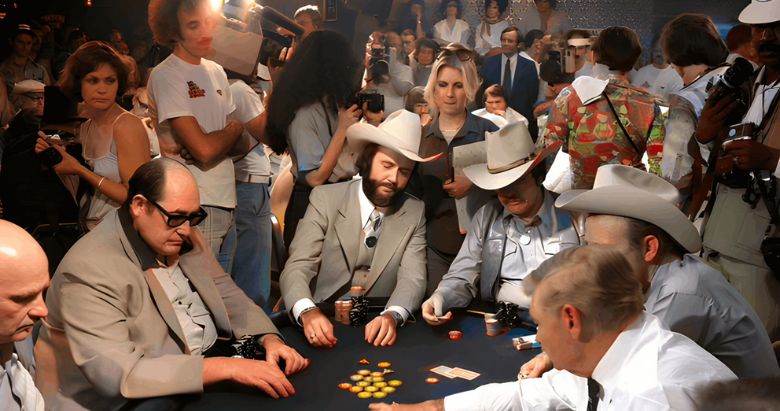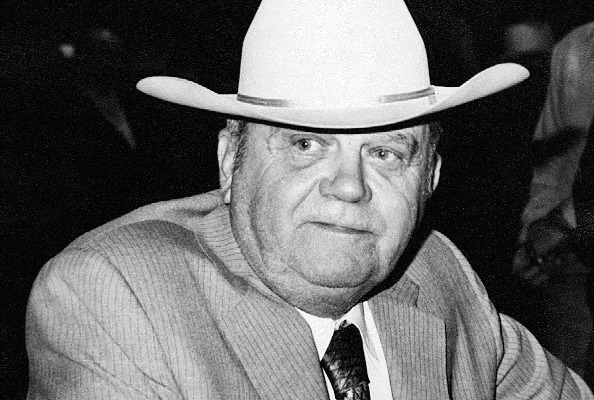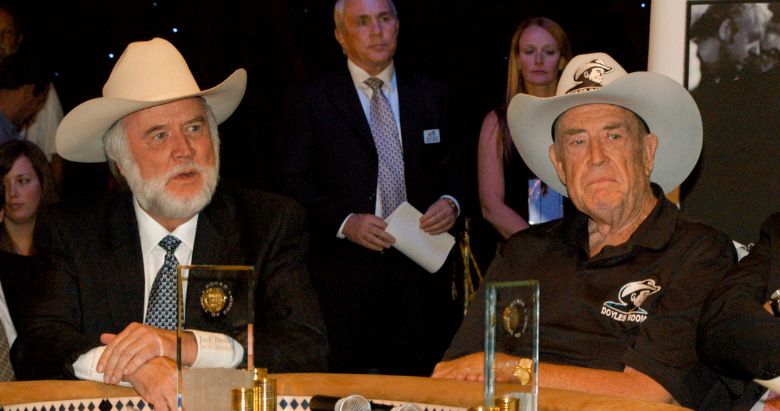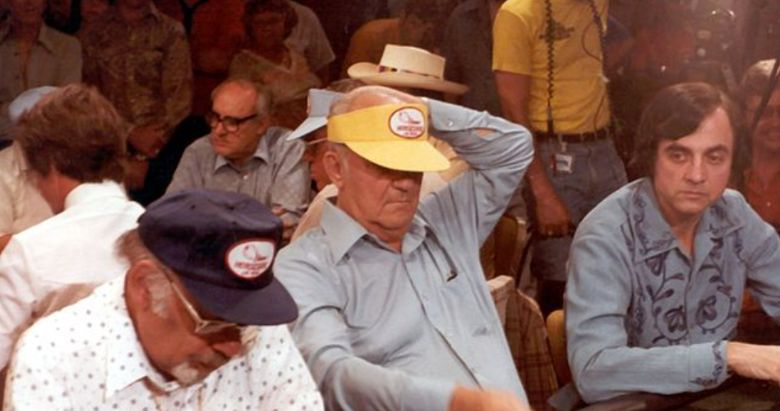Crandell Addington: A WSOP Pioneer’s Story


- Fact Checked by: PokerListings
- Last updated on: July 11, 2024 · 5 minutes to read
Crandell Addington, born on June 2, 1938 in Graham, Texas, remains a seminal figure in the world of poker. This detailed exploration covers his journey from the early days at the Texas Gamblers Convention to his foundational role in the creation of the World Series of Poker (WSOP).
It also highlights his dual legacy as both a fierce competitor at the poker table and a successful entrepreneur in oil and biotechnology sectors. Delve into the life of a man who not only shaped poker tournaments as we know them today but also transformed personal challenges into strategic business victories.
Crandell first entered the poker scene in 1969 when he conquered a tournament in Reno (Nevada), part of a series called the Texas Gamblers Convention, a name that means little to a 21st-century poker enthusiast. Even calling it a “tournament series” is a bit of a stretch. At that time, the idea of a freezeout tournament, which would determine the best player, hadn’t yet emerged. The game was played at cash tables, and the winner was determined by the best result.
The games were held at the Eldorado Club and were organized by Tom Moore, the owner of the Hotel Apache, as a way of attracting new customers. Unfortunately for him, the attendees played poker non-stop and smoked cigars, which didn’t result in any additional sales. As a result, the series was not held the following year.


However, Benny Binion picked up the idea of the “Texas Gamblers Convention” after asking Tom Moore for permission. If Moore had no plans to continue with poker, Crandell quickly realized that Benny could develop and successfully scale the idea. Ultimately, as the creator of the idea, Crandell gave permission to Benny Binion, which led to the creation of the WSOP.
The next game was organized by Jack Binion in 1970. It took place at the Horseshoe Casino, which was owned by the Binion family. Crandell Addington participated in the very first game.
By this point, Crandell was only 32 years old, and besides his success in Reno the previous year, he already had a successful business and was a millionaire. By then, Addington had earned enough to play poker for pleasure, regardless of the result he achieved in the WSOP and high-stakes games that took place simultaneously with the series.
In 1971, Addington missed the WSOP 1971 series — the first in which the winner was determined by tournament results. At that time, Addington was participating in a high-stakes game. According to his recollections, this took place in Canada or Mexico.
In subsequent interviews, he repeatedly spoke about how the game was enjoyable for him, and success at the poker table was more about the personal challenge of it all.
Poker Achievements
| Year | Achievement | Winnings |
|---|---|---|
| 1973 | 1st Place at the No Limit Hold’em Tournament (Event #6) at WSOP 1973 | $17,000 |
| 1974 | 3rd place in the WSOP 1974 2-7 Draw Tournament (Event #4) | $14,150 |
| 1978 | 2nd place at the ME WSOP 1978 in No Limit Hold’em | $84,000 |
| 1989 | 36th place at the ME WSOP 1989 in No Limit Hold’em | $7,500 |
| 1990 | 2nd place at the Hall of Fame Poker Classic in No Limit Hold’em | $1,500 |
In the early stages of the WSOP, tournaments were conducted so that the winner took all the prize money. Crandell often finished second in key tournaments of the series, so despite good results, he couldn’t boast a large win.
In 1974 and 1979, Crandell took second places at the ME WSOP. In total, during the 1970s, he played at the final table of the ME WSOP seven times. This result remains an unbeaten record.
In recorded poker tournaments, Crandell earned $179,350.
Education and Career
Crandell Addington received his education at The Southwestern University (Class of 1961) in Economics and Accounting. After this, Addington pursued further education in multiple scientific fields at Trinity University in San Antonio, Texas.
He lived in Nevada for a while, where he played poker, but then returned to San Antonio, Texas, to engage in business.


In the 1980s, Crandell left poker and focused on his business. His areas of interest were the oil business and biotechnology. His company, Addington Enterprises, was involved in oil extraction in Texas for over 30 years. Additionally, he was a co-founder of Phoenix Biotechnology, where he also served as CEO and Chairman.
Facts About Crandell Addington
While we discuss some of the more interesting facts about Crandell Addington, we have to begin with his speech at Harvard University, where Crandell talked about how in the 1960s and 1970s, he, like other players, carried weapons. They were not used against each other. What they really wanted was, if they won, to be able to get back to the car with the money. And so, not only did they have to beat a lot of really good players, but they had to dodge the hijackers and often the sheriff of the county.
During the same time, in the 1960s, Crandell moved from San Antonio to Reno with a friend who wanted to buy a casino to organize high-stakes poker games. This is how he became one of the organizers of the Texas Gamblers Convention and won in the same series.
And then, when the WSOP series first started, out of all the players, only Crandell Addington and Doyle Brunson had a university education.


Surprisingly enough, in the 1970s, gambling enthusiasts did not specialize in poker. So, while Addington and Brunson were playing, they often opted to do several games simultaneously and chose tables with weak players and real money. Brian “Sailor” Roberts was the first to choose poker as his main specialization and thought about forming an effective poker strategy.
Addington was the first in a conversation with Roberts to suggest isolating a pre-flop player because they were unlikely to hit the cards on the flop and could be pushed out of the deal by taking the chips.
In 1976, Doyle Brunson won the WSOP, but the four remaining players agreed to split the $220,000 prize money. Each chip at the table corresponded to $1, and the players fixed 75% of their stacks, with the remaining 25% going to the winner. Addington was the chip leader at the time of the deal, so he took a large prize, but on paper, the victory and the entire prize went to Brunson, who was then forced to pay taxes for all other players.
In 1977, the situation repeated itself, so from 1978, Benny Binion devised a way to distribute the prize among several players.
In 2005, Crandell Addington was inducted into the Poker Hall of Fame simultaneously with the creator of the WSOP, Jack Binion. The legendary player passed away on April 14, 2024. Crandell requested his ashes be spread over his animal friends, in particular his black lab, Miss Joey.
-
Stake.US Poker4.3
- Rakeback 5%
- $55 Stake Cash + 260K Gold Coins
T&Cs Apply | Play Responsibly | GambleAware
18+ | Play Responsibly | T&C Apply
-
Appeak Poker4.1
- 1,000 Chips Daily
- FREE 5,000 Chips
T&Cs Apply | Play Responsibly | GambleAware
T&Cs Apply | Play Responsibly | GambleAware
-
- 2,500 Gold Coins + 0.50 Sweeps Coins
T&Cs Apply | Play Responsibly | GambleAware
18+ | Play Responsibly | T&C Apply
-
WSOP.com4.3
- Up to 70%
- 100% up to $1000
T&Cs Apply | Play Responsibly | GambleAware
T&Cs Apply | Play Responsibly | GambleAware
-
CoinPoker4.1
- 33% Weekly
- 150% up to 2000$
T&Cs Apply | Play Responsibly | GambleAware
+18 / T & C apply / Play responsible


